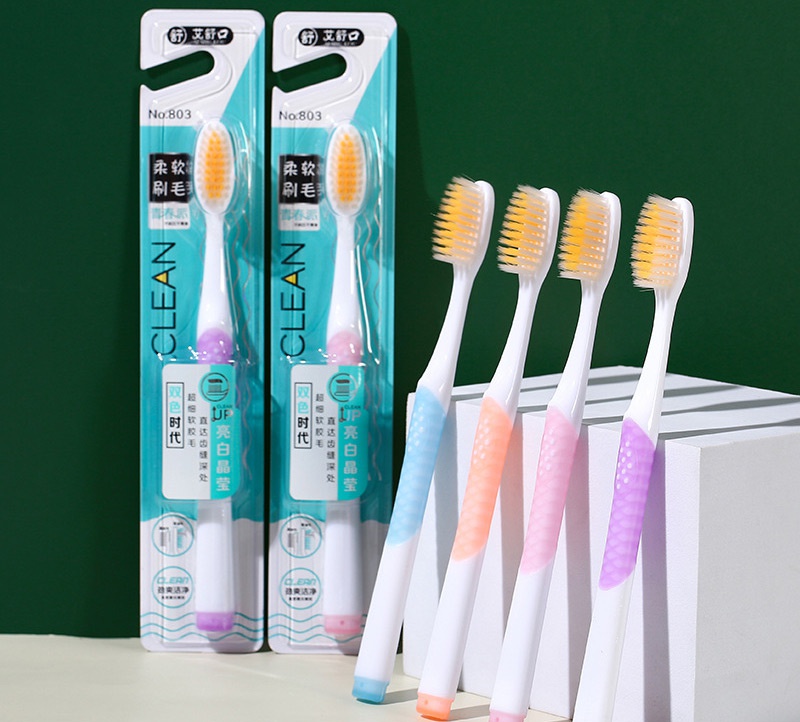Brushing teeth is the simplest and most effective way for us to protect our teeth and prevent dental caries. As an important tool for brushing teeth, toothbrushes directly affect our oral health. So, how to choose a good toothbrush?

Firstly, we need to replace a new toothbrush every three months. If you find that the bristles of the toothbrush have become messy, you should replace them in a timely manner.
Secondly, a good toothbrush must meet the following conditions.
Although harder bristles have better cleaning effects, they also cause greater wear and damage to teeth. When purchasing a toothbrush, you can press the bristles with your fingers. If your fingers feel stimulated, it means they are too hard and it is not recommended to purchase. The bristles are too soft, making it difficult for users to control the force of the brush. Brushing too lightly and not thoroughly cleaning; Excessive force can damage the gums. Therefore, it is recommended to choose a toothbrush with moderate bristle softness and hardness. The bristles will have sharp cuts after cutting, so it is best to choose bristles that have been polished.
Flat type: This is the most common type of brush head, with evenly arranged bristles that can basically meet daily cleaning needs.
Wave shaped: The bristles are arranged in a wave shaped undulating pattern, which is more in line with the curvature of the teeth, making it easier to contact adjacent positions of the teeth. The cleaning power of the bristles is also slightly stronger.
Top tuft long type: More commonly used in orthodontic toothbrushes, it can clean areas that ordinary toothbrushes cannot reach.
Cross type: The brush head is composed of bristles made of multiple materials, which provides better cleaning effect.
Cup shaped: The bristles are arranged in a circular cup shape, which can wrap around the teeth and effectively clean the dirt on the surface of the teeth.
The handle of a toothbrush should be easy to grip and have an anti slip design to prevent the toothbrush from slipping off during brushing. There are two common types of toothbrush handles on the market: straight and angled. It is difficult to control the force when using a straight brush handle; Using an angled brush handle makes it easier to reach the plaque area. It should be noted that the angle between the handle and head of the toothbrush should be between 17-20 degrees.
Some people are worried that electric toothbrushes may damage their teeth, which is really worrying. At present, mainstream electric toothbrushes are divided into two types: rotary and sonic vibration. The difference in strength between these two electric toothbrushes is not significant, but the average brushing force is lower than that of manual toothbrushes, resulting in less damage to teeth.
Choosing an electric toothbrush with low body vibration and noise can not only prevent numbness in the palms caused by long-term use of the toothbrush, but also avoid the impact of excessive noise on mood. And the battery determines the endurance and service life of the electric toothbrush. It is recommended that you choose an induction charging electric toothbrush.
Is it true that brushing teeth cannot be dipped in water?
There is a saying that when you dip your teeth in water, you brush them for nothing. Because toothpaste will quickly bubble when dipped in water, making people mistakenly think that they have already brushed enough, but in fact, it has not yet had a cleaning effect. In fact, toothpaste does not rely on foam to clean teeth, but on the cleaning ingredients of toothpaste and the friction between toothbrush and teeth. Even if not dipped in water when brushing teeth, saliva will still be secreted in the mouth. So, whether dipping in water has a direct impact on teeth cleaning or not, the key is to ensure that you brush your teeth for 3 minutes each time. However, the effective ingredients of some desensitizing and whitening toothpastes will quickly decompose when they come into contact with water, so it is not advisable to dip them in water when brushing teeth with these toothpastes.











